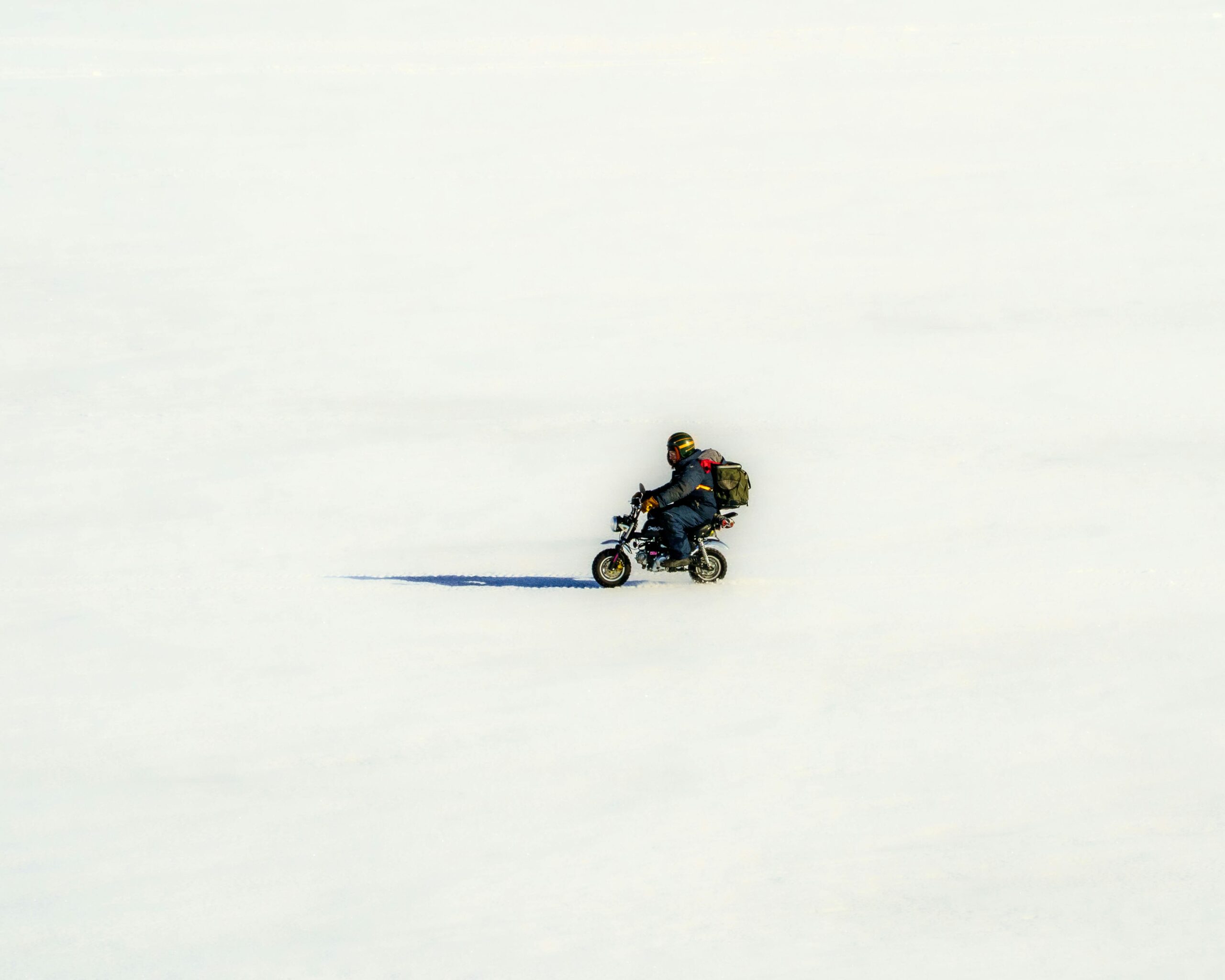Have you ever felt overwhelmed trying to choose the right winter motorcycle gear for beginners?
You’re not alone — many new riders feel unsure about how to dress for cold-weather riding without compromising safety or comfort. According to the Motorcycle Industry Council, over 30% of beginner riders delay riding in colder months simply because they don’t feel adequately equipped. That hesitation can lead to lost riding time and even dangerous last-minute decisions when weather unexpectedly shifts.
Interestingly, my husband and I know all about winter riding. Because we live in mid-northern Canada, we have very short summers and suffer on average nine months of winter per year. These are not your ordinary winters too. Most of the winter we hover below zero degrees celsius, and often go down to -30C and more. If we didn’t know how to dress for the cold, we’d probably never ride!
Therefore, with a few simple guidelines and the right gear choices, you too can ride through winter with confidence, warmth, and safety.
Let’s get you ready to take on the cold.
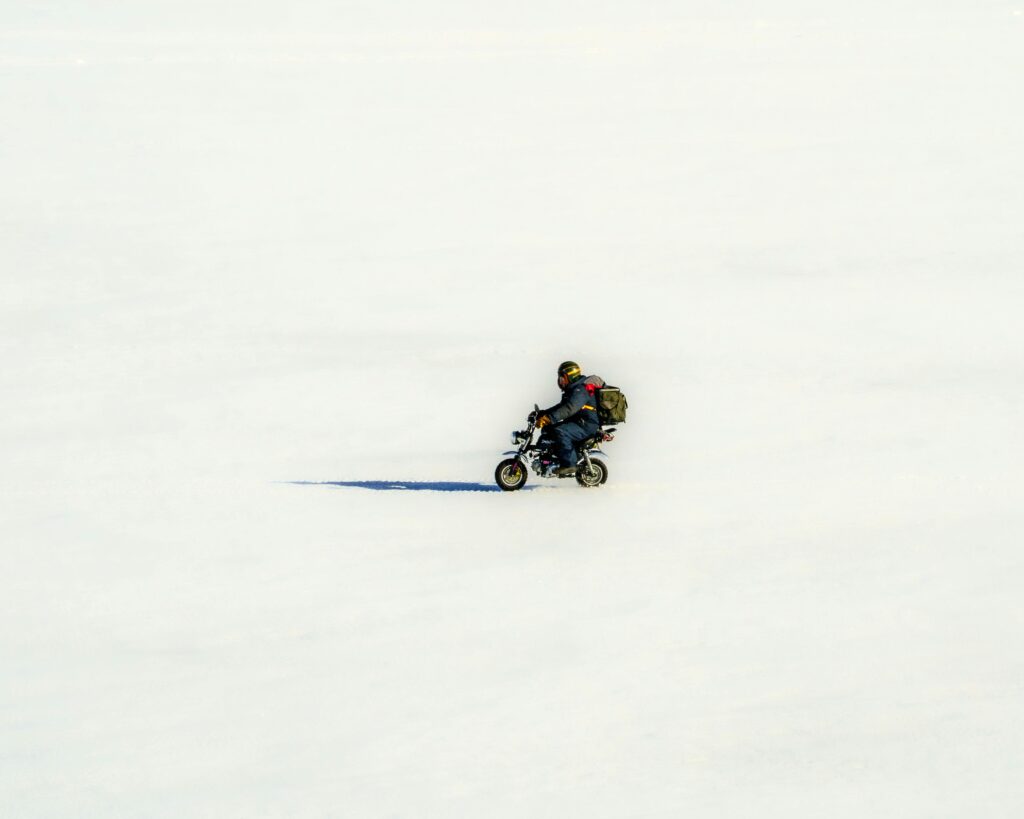
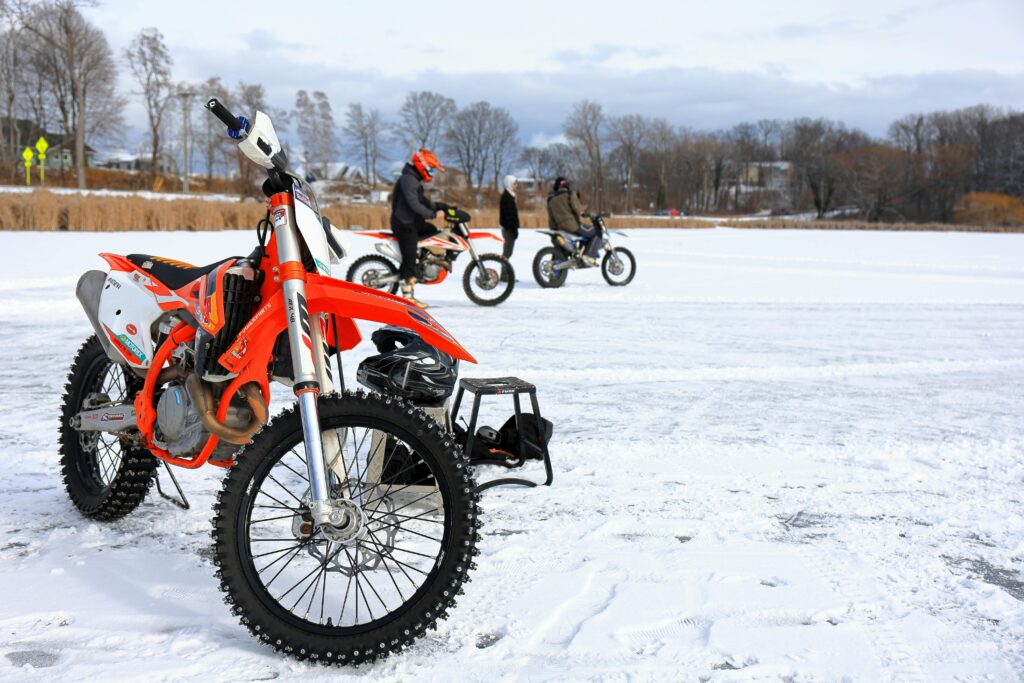
Winter Motorcycle Gear for Beginners: Why It Matters
When it comes to riding in cold weather, preparation isn’t optional — it’s critical.
Motorcycling in winter presents unique challenges — from freezing temperatures and icy roads to limited daylight and unpredictable weather. Without appropriate gear, beginners are especially vulnerable to cold-induced fatigue, delayed reactions, and loss of dexterity, which can lead to dangerous situations on the road. Cold can numb your fingers, stiffen your joints, and fog up your visor, impairing your ability to react swiftly. Proper gear regulates your temperature, protects against wind chill and moisture, and enhances your visibility in gloomy conditions. Preparing for the cold therefore isn’t a luxury — it’s a necessity and a critical safety measure.
Hence, investing in the right winter motorcycle gear for beginners not only boosts your confidence but also significantly reduces your risk during winter rides.
Pro Tip: When I first visited Canada as a dental student, “winter” had no meaning to me. How cold could it be? On my very first day it was -20C, and I soon learned that although you can cut corners in summer, winter has no mercy. Always be prepared for the cold, or you might literally freeze.

Layering Essentials: Building a Cold-Weather Riding System
Staying warm while riding doesn’t require bulky outfits — on the other hand, it requires strategic layering. For beginner riders, understanding how to layer can make all the difference between a miserable ride and a comfortable one.
Start with a moisture-wicking base layer made of merino wool or synthetic fabric. This keeps sweat away from your skin and helps regulate your core temperature. Over that, add an insulating mid-layer, such as fleece or synthetic down, to trap body heat.
Your outer layer is your armor against the elements. Choose a waterproof, windproof motorcycle jacket and pants with thermal liners. Look for CE-rated protection and breathable membranes like Gore-Tex to prevent overheating.
As a result, this system allows you to adapt to changing weather by adding or removing layers — ideal for unpredictable winter rides.
To find out more about how to choose and layer base layers effectively, check out our full guide on motorcycle base layers for beginners.
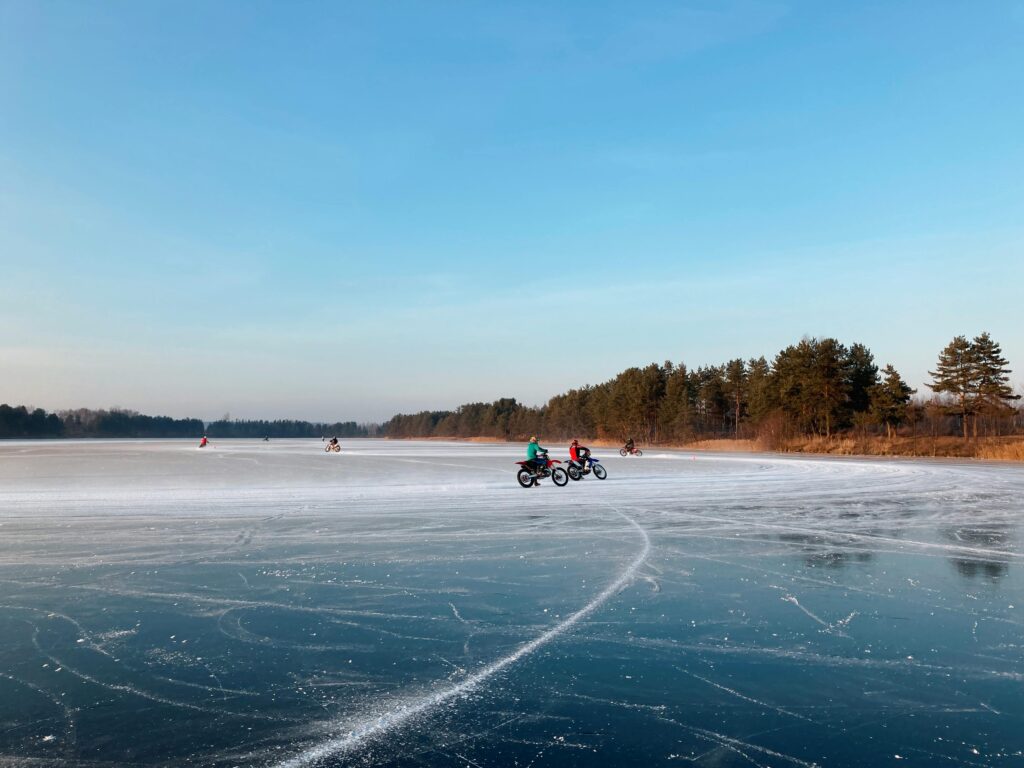
Motorcycle Jackets for Winter
A well-chosen jacket is your first line of defense against the cold, wind, and moisture. For beginners, the right winter motorcycle jacket balances protection, comfort, and functionality.
- Thermal insulation: Look for removable liners or built-in thermal layers to adapt to changing temperatures.
- Windproof and waterproof materials: Prioritize jackets with laminated membranes or waterproof shells (e.g. Gore-Tex alternatives).
- Abrasion resistance: Choose jackets made of textile materials like Cordura or reinforced polyester for durability.
- Impact protection: Ensure CE-rated armor is included or can be added to the shoulders, elbows, and back.
- High collar and storm flaps: These prevent wind from entering at the neck and chest area.
- Adjustability: Waist and cuff adjusters help retain warmth and customize the fit.
- Visibility: Reflective panels or piping enhance your presence in low-light conditions.
As you can see, a proper winter jacket keeps your core warm — a crucial part of staying alert and reactive in cold conditions.
If you’re looking for more tailored guidance, especially when it comes to fit and protection, check out our complete guide on how to choose a motorcycle jacket for women.
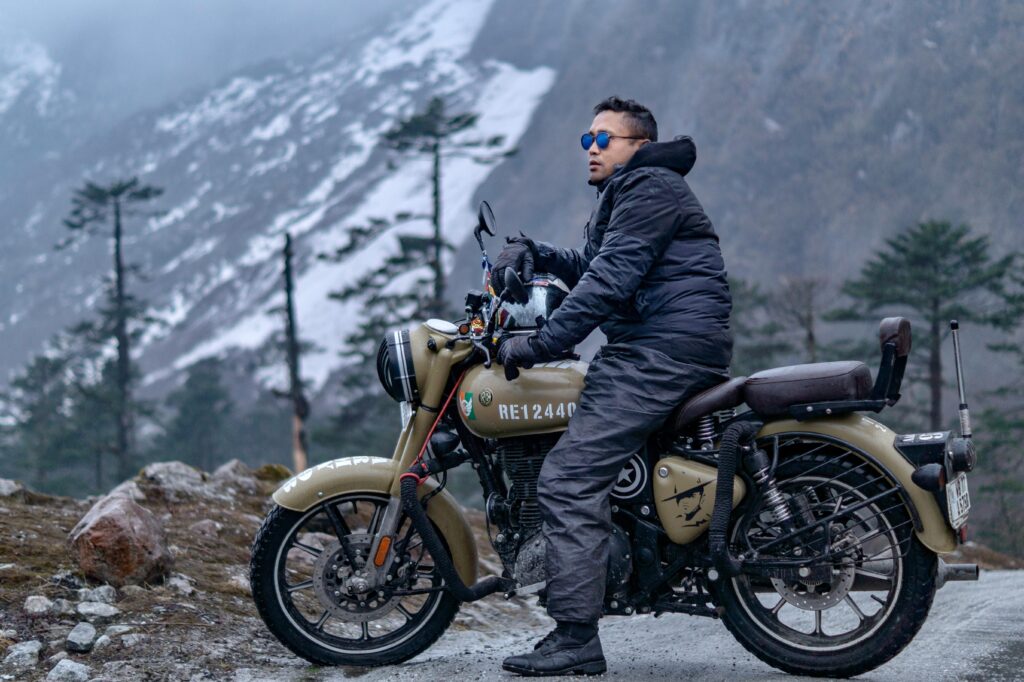
Motorcycle Pants for Winter
Your lower body takes the brunt of wind chill, especially at highway speeds. Winter riding pants need to insulate, protect, and stay comfortable during long rides.
- Thermal lining: Like jackets, pants with removable thermal liners let you adapt to variable weather.
- Waterproof protection: Look for waterproof shells or integrated liners to stay dry in rain and snow.
- Abrasion resistance: Durable textile construction with reinforced zones (hips, knees, seat) is essential.
- Armor: CE-rated knee and hip protectors provide critical impact protection.
- Fit and flexibility: Pre-curved legs, stretch panels, and waist adjusters improve comfort on the bike.
- Boot compatibility: Pants should fit over winter boots and include zippers or Velcro to keep them snug.
- Ventilation zips: On milder days, vents allow airflow without compromising wind protection.
Evidently, investing in the right winter pants ensures you stay warm from the waist down — without sacrificing protection or comfort on long winter rides.
Pro Tip: As a beginner (passenger, of course), I didn’t fully grasp how cold and distracting wind chill can be. If you already have motorcycle pants that work quite well for you, consider only buying wind-resistant, waterproof shell-style pants. Similar to a windbreaker, these you can pull over your current motorcycle pants and spare yourself some freezing wind.
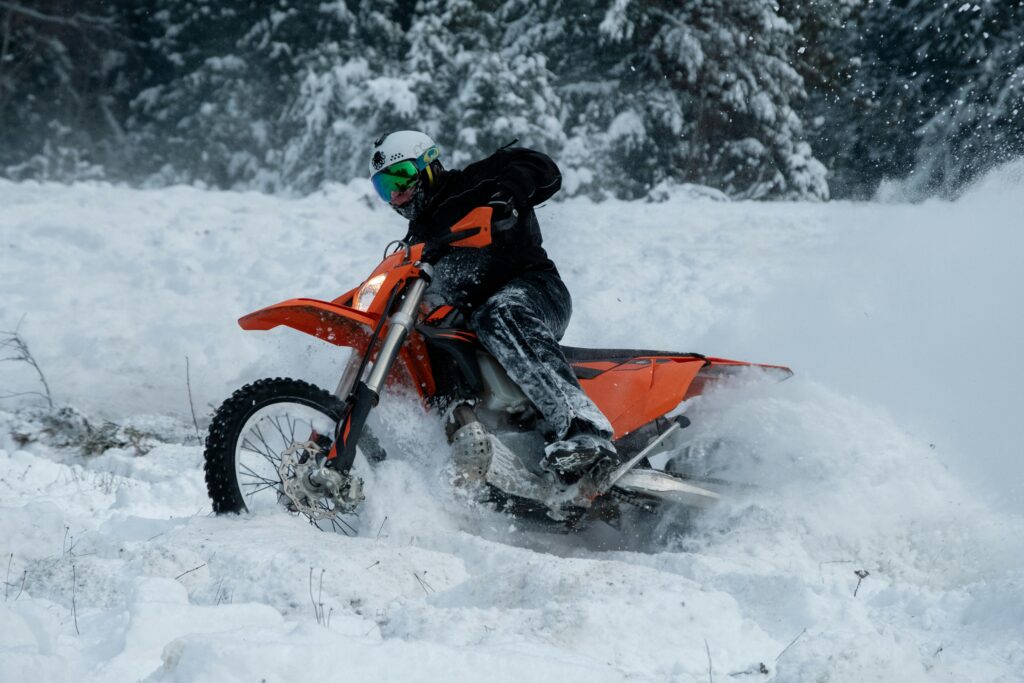
Motorcycle Gloves for Winter
Your hands are one of the first body parts to feel the effects of cold, and numb fingers can seriously affect your ability to brake, shift, and steer. Choosing the right winter motorcycle gloves is essential for both safety and comfort.
- Insulation: Look for thermal linings such as Thinsulate or fleece that offer warmth without sacrificing dexterity.
- Waterproofing: Gloves with a waterproof membrane (e.g., Hipora, D-Dry) or laminated shell help keep your hands dry in wet and snowy conditions.
- Windproof materials: Wind chill dramatically lowers skin temperature at speed — a windproof barrier is a must.
- Gauntlet-style cuffs: Longer cuffs that go over the jacket sleeve seal out cold air and precipitation.
- Secure closures: Look for dual-closure systems with Velcro or wrist straps to ensure a snug, draft-free fit.
- Armour and reinforcement: CE-rated knuckle protection, reinforced palms, and abrasion-resistant fabrics enhance safety.
- Touchscreen compatibility: Helpful for GPS use or phone access without removing your gloves in the cold.
- Pre-curved fingers: Improve comfort and reduce fatigue on longer rides.
Well-designed gloves make the difference between enduring a ride and enjoying it. For maximum warmth, consider pairing gloves with heated grips or hand guards.
For a deeper breakdown of essential glove features and tips on choosing the right pair, don’t miss our full guide on how to choose motorcycle gloves for beginners.

Motorcycle Boots for Winter
Your feet are exposed to wind, water, and road spray, especially during long winter rides. Proper winter motorcycle boots protect against the elements while offering the support and safety beginners need.
- Waterproofing: Look for boots with a waterproof membrane or sealed seams to keep your feet dry in wet and snowy conditions.
- Thermal insulation: Insulated linings (such as fleece or thermal foam) help retain body heat without making the boots bulky.
- Ankle and shin protection: Reinforced areas and CE-rated armour around the ankle, heel, and shin provide impact protection.
- Grippy sole: A high-traction rubber sole helps prevent slipping when stopping on icy or wet pavement.
- Mid-to-high cut: Taller boots provide better weather protection and support than ankle-height styles.
- Gear shift reinforcement: A strengthened toe area prevents wear and adds comfort when shifting gears.
- Closure system: Look for boots with secure and adjustable fastenings, such as zippers with Velcro flaps or ratchet systems, to create a snug, wind-resistant seal.
Wearing the right winter boots improves your warmth, stability, and safety — all crucial for confident cold-weather riding.
For more advice on features to look for and how to find the right fit, check out our guide on how to choose motorcycle boots for beginners.
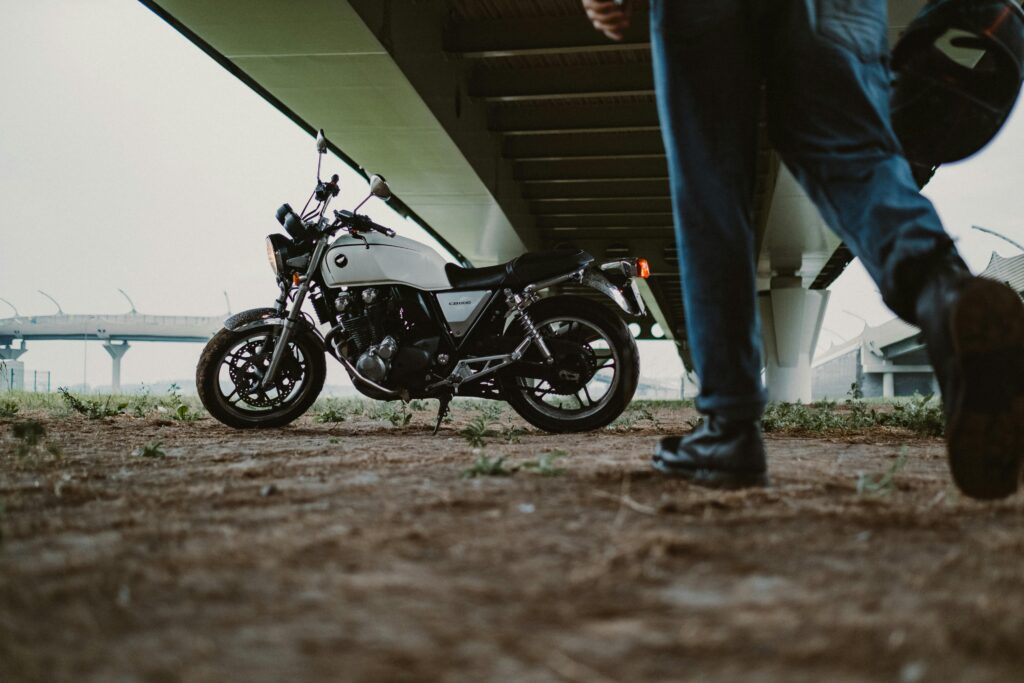
Cold Weather Accessories for Winter Motorcycle Riding
Beyond your core gear, the right accessories can dramatically improve your comfort, visibility, and safety on winter rides. These finishing touches help seal out the cold and make your setup more adaptable to varying conditions.
- Balaclavas and neck warmers: A thermal balaclava or fleece neck tube helps insulate the most exposed parts of your body—your neck, lower face, and head—while fitting comfortably under your helmet.
- Heated grips or handlebar muffs: These keep your hands warm and responsive, even in sub-zero temperatures. Handlebar muffs are especially helpful for beginners who aren’t ready to invest in heated gear.
- Heated gear (vests, liners, socks): Battery-powered or plug-in heated layers offer a customizable level of warmth, perfect for long-distance or all-day riding.
- Wind deflectors and hand guards: These small modifications to your bike help shield your hands and torso from wind chill, reducing fatigue and the need for heavier gear.
- Hi-vis vests or reflective accessories: With shorter days and poor visibility, adding reflective strips or high-visibility overlays increases your presence on the road.
- Anti-fog inserts or visor treatments: These help maintain clear vision in cold, damp conditions—essential for safe winter riding.
While not always essential, cold weather accessories provide targeted comfort and can make a big difference in how long—and how safely—you can ride during the winter months.
Pro Tip: My husband made himself handlebar muffs for his bike – which he diligently tapes on and off every year for Canadian winters. He rides pretty much until snow hits the ground, only wearing thing gloves inside the hand guards. The DIY setup is very ugly, but it seems to work very well!
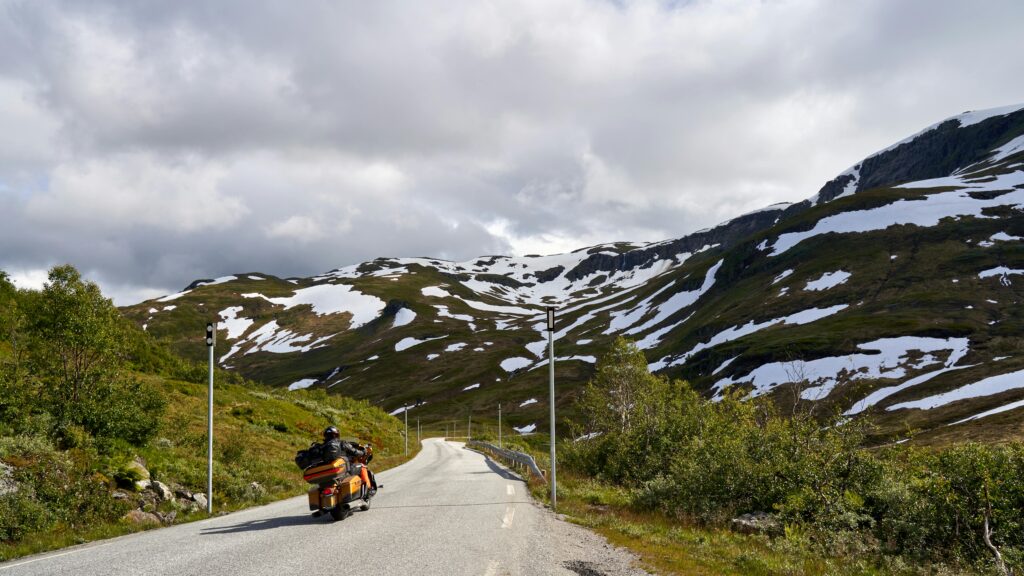
Budgeting for Winter Motorcycle Gear
When starting out, prioritizing your spending on winter motorcycle gear for beginners helps you stay warm and safe without overspending. Focus on the essentials first:
- Gloves, jacket, and boots: These are the most critical items to protect against cold and maintain safety on the road.
- Base layers: Once your main gear is covered, add thermal base layers to regulate body temperature and enhance comfort.
- Bike modifications: Consider affordable upgrades like handlebar muffs and wind deflectors to reduce wind chill and improve riding comfort.
- Heated gear: If you ride frequently in cold climates or for long distances, investing in heated gloves, vests, or insoles can be a game changer.
To save money, look for off-season sales or second-hand options for non-safety gear like jackets and gloves. However, make sure to always buy helmets and boots new for maximum protection.
For a broader overview on essential gear, check out our complete motorcycle gear guide for beginners.
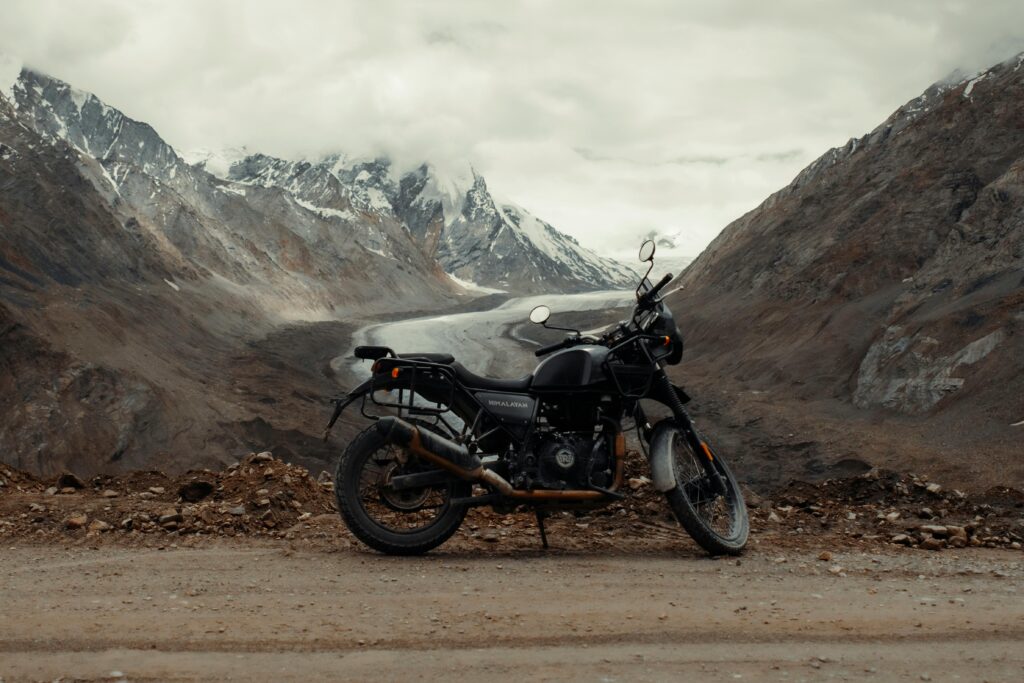
FAQ: Winter Motorcycle Gear for Beginners
Q. What’s the warmest motorcycle gear for winter?
Heated gear provides the warmest and most consistent protection. For maximum warmth, use a full heated gear system powered by your motorcycle battery. This can apply to motorcycle jackets, vest, gloves and pants.
Q. Can beginners ride motorcycles in snow?
It’s not recommended for beginners to ride in heavy snow due to traction loss and visibility issues. If you must, ensure your gear includes thermal protection, reflective materials, and your tires are suited for winter conditions.
Q. Is leather good for winter motorcycle gear?
Leather offers great abrasion protection but lacks insulation and water resistance. For winter, textile gear with thermal liners and waterproof membranes is more practical for new riders.
Q. Do I need a specific winter helmet?
You don’t need a special helmet. However, you may benefit from cold-weather features like anti-fog visors, breath guards, and wind-blocking accessories like balaclavas and chin curtains.
Q. How can I keep my face from freezing during winter rides?
Use a full-face helmet with a thermal balaclava, windproof neck gaiter, and anti-fog shield. Proper helmet ventilation will also prevent frost buildup inside the visor.

Final Thoughts
Cold weather doesn’t have to sideline your riding — not if you’re geared up right. Winter motorcycle gear for beginners is all about strategic layering, thermal protection, and smart equipment choices. Start with essential items like insulated gloves, waterproof jackets, and solid boots, then explore upgrades like heated gear and visibility enhancements. Always make sure to consider your riding style and seasonal conditions, and invest accordingly.
Let me know in the comments what winter motorcycle gear has saved you from freezing!
Dreaming about warm weather adventures after all this talk of winter? Explore tips and guides for summer motorcycle travel in Italy, Mallorca, and closer to home, in Sylvan Lake, AB.

